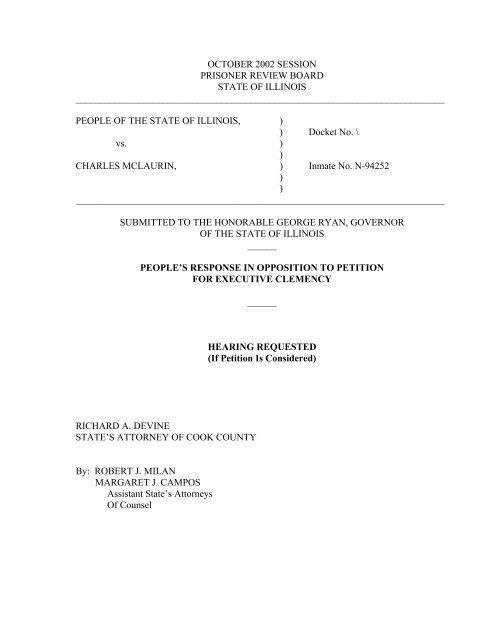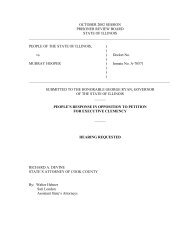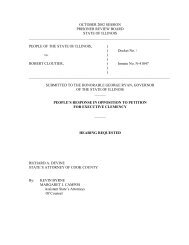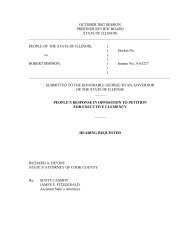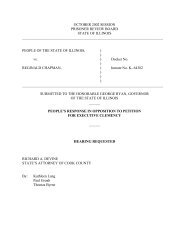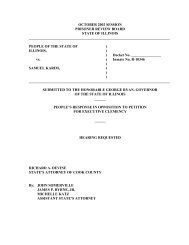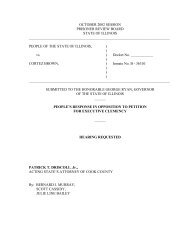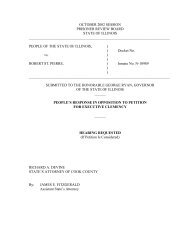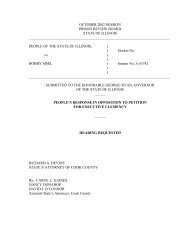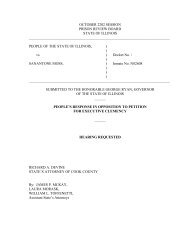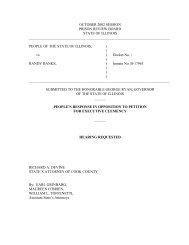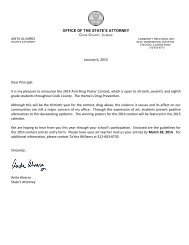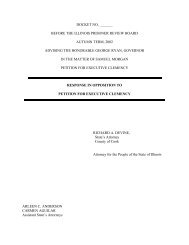Charles McLaurin - Cook County State's Attorney
Charles McLaurin - Cook County State's Attorney
Charles McLaurin - Cook County State's Attorney
Create successful ePaper yourself
Turn your PDF publications into a flip-book with our unique Google optimized e-Paper software.
OCTOBER 2002 SESSION<br />
PRISONER REVIEW BOARD<br />
STATE OF ILLINOIS<br />
____________________________________________________________________________<br />
PEOPLE OF THE STATE OF ILLINOIS, )<br />
) Docket No. \<br />
vs. )<br />
)<br />
CHARLES MCLAURIN, ) Inmate No. N-94252<br />
)<br />
)<br />
____________________________________________________________________________<br />
SUBMITTED TO THE HONORABLE GEORGE RYAN, GOVERNOR<br />
OF THE STATE OF ILLINOIS<br />
______<br />
PEOPLE’S RESPONSE IN OPPOSITION TO PETITION<br />
FOR EXECUTIVE CLEMENCY<br />
______<br />
HEARING REQUESTED<br />
(If Petition Is Considered)<br />
RICHARD A. DEVINE<br />
STATE’S ATTORNEY OF COOK COUNTY<br />
By: ROBERT J. MILAN<br />
MARGARET J. CAMPOS<br />
Assistant State’s <strong>Attorney</strong>s<br />
Of Counsel
OCTOBER 2002 SESSION<br />
PRISONER REVIEW BOARD<br />
STATE OF ILLINOIS<br />
____________________________________________________________________________<br />
PEOPLE OF THE STATE OF ILLINOIS, )<br />
) Docket No. \<br />
vs. )<br />
)<br />
CHARLES MCLAURIN, ) Inmate No. N-94252<br />
)<br />
)<br />
____________________________________________________________________________<br />
PEOPLE’S OBJECTION TO UNTIMELINESS<br />
OF MCLAURIN’S CLEMENCY PETITION<br />
The People strenuously object to <strong>McLaurin</strong>’s late and untimely filing of his clemency<br />
petition. The Prisoner Review Board very clearly set a time frame in which his petition was<br />
due. That date was August 26, 2002. Without any justification for his delay, <strong>McLaurin</strong> filed<br />
his petition on September 19, 2002. Due to this untimely filing, the People have not had an<br />
adequate amount of time to review, prepare and respond to his petition.<br />
Additionally, it must be noted that <strong>McLaurin</strong> signed his verification and consent affidavit<br />
on August 22, 2002, obviously without having read his petition since the petition was not filed<br />
on September 19, 2002. This is a clear violation of the Prisoner Review Board’s Rules. As<br />
such, <strong>McLaurin</strong>’s petition must be rejected. Assuming, however, this Board’s and the<br />
Governor’s review of this petition despite these violations, the People respectfully respond to<br />
and strongly oppose <strong>McLaurin</strong>’s petition.<br />
1
I<br />
HISTORY OF THE CASE<br />
After being paroled from prison for robbing and shooting an 82 year old man,<br />
petitioner, <strong>Charles</strong> <strong>McLaurin</strong>, then increased his level of ferociousness when, in this case, he tied<br />
a naked 17-year old Jarrell Edwards to a chair with his hands behind his back, repeatedly sliced<br />
into Jarrell’s chest, face and neck with a pearl-handled straight razor, watching him squirm and<br />
ooze blood from his chest. Ignoring Jarrell’s pleas to let him live, <strong>McLaurin</strong> then doused Jarrell<br />
with gas and set him on fire. In the last moments of his life, Jarrell’s voice box, windpipe and<br />
lungs filled up with the smoke he inhaled from his own burning body until his skin charred<br />
and split and he finally died of carbon monoxide intoxication. Shortly thereafter, firefighters<br />
determined that Jarrell had been severely burned, was not breathing and could not be resuscitated.<br />
<strong>McLaurin</strong> was indicted for first degree murder, first degree murder based upon a<br />
felony, home invasion, aggravated arson, possession of a stolen motor vehicle and residential<br />
burglary. <strong>McLaurin</strong> decided to represent himself and the counsel that had represented <strong>McLaurin</strong><br />
for the previous two years was appointed as stand-by counsel. When testifying on his own behalf,<br />
<strong>McLaurin</strong> never denied that he committed the murder. After a jury trial before the Honorable<br />
Paul J. Nealis, <strong>McLaurin</strong> was found guilty of all charges. <strong>McLaurin</strong> waived a jury and chose to<br />
have appointed counsel represent him during his sentencing hearing. The court found <strong>McLaurin</strong><br />
death eligible. After listening to evidence in aggravation and mitigation, the court sentenced<br />
<strong>McLaurin</strong> to death for the first degree murder, 60 years’ incarceration for the home invasion, 30<br />
years’ incarceration for the aggravated arson, 15 years’ for the residential burglary and seven<br />
years’ incarceration for possession of a stolen motor vehicle, all sentences to run concurrently.<br />
2
II<br />
FACTS OF THE CASE<br />
The People’s Case-In-Chief<br />
On August 15, 1992, Delshea Ingram, <strong>McLaurin</strong>’s common-law wife, lived in Sauk<br />
Village with defendant, his sister, Carolyn, Carolyn’s three children, Carolyn’s boyfriend, Latisha<br />
Lewis and Latisha’s boyfriend. On that date, Delshea took Carolyn’s three children to a park<br />
about a block and a half away. At the park, the victim, seventeen-year-old Jarrell Edwards,<br />
walked up and flirted with Delshea. Jarrell’s parents were out of town and he invited Delshea to a<br />
party he was having that night. Delshea never told him that she was married.<br />
Later that night, about 9:00 p.m., Delshea told Carolyn that she had to buy cigarettes.<br />
Rather than go to the store, Delshea walked to Jarrell’s house, which was approximately a block<br />
and a half away from her home on Peterson. When Delshea arrived at Jarrell’s house, no one was<br />
home. As Delshea started walking back, Jarrell drove up in a two-door blue Oldsmobile or Chevy.<br />
Jarrell got out of his car, unlocked the garage door, walked back to the car and grabbed a bag from<br />
the back seat. Jarrell and Delshea then walked up to the porch.<br />
The phone rang and Jarrell went inside for a few minutes. When he returned, Jarrell<br />
and Delshea talked on the porch for about fifteen or twenty minutes. Delshea asked Jarrell for a<br />
glass of water and then, about ten minutes later, asked if she could use his bathroom. Jarrell took<br />
her inside. Delshea returned to the porch and they talked for about ten minutes more.<br />
Delshea left and <strong>McLaurin</strong> was home when she returned. Later that night, a young man<br />
rang the doorbell and asked for <strong>McLaurin</strong>. This man, <strong>McLaurin</strong> and Delshea sat in the kitchen and<br />
planned the robbery of Jarrell Edwards. The three devised a plan: Delshea was to enter Jarrell’s<br />
house and leave the door unlocked allowing <strong>McLaurin</strong> and the other man to enter the home and<br />
begin the crime. <strong>McLaurin</strong> dressed in black pants, black sandals, black socks and a black starter<br />
jacket. Delshea started walking about fifteen minutes after the two men left in a car. She rang<br />
3
Jarrell’s doorbell about midnight and he let her in.<br />
The phone rang and Jarrell answered it. After he hung up, Delshea and Jarrell went into<br />
his bedroom and, sitting on Jarrell’s bed, talked and flirted for fifteen to twenty minutes. To stall<br />
for time, Delshea asked to use the bathroom.<br />
About five to ten minutes later, Delshea opened the bathroom door and turned off the<br />
light. When she stepped into the hallway, Jarrell’s bedroom light and the basement light went out.<br />
Delshea heard <strong>McLaurin</strong> call to her from Jarrell’s bedroom, “Dee, get out of the house.” Delshea<br />
walked toward the steps to leave the house, but the other man grabbed her and led her back to<br />
Jarrell’s bedroom.<br />
Jarrell sat in a wooden chair, naked, with his hands tied behind his back and a scarf<br />
wrapped around his mouth. After the lights were turned on, <strong>McLaurin</strong> stood in front of the victim,<br />
and asked him if he would go to the police. Delshea thought that Jarrell misunderstood the<br />
question, because he responded, “yes.” After that answer, <strong>McLaurin</strong> reached into his pocket and<br />
pulled out a straight razor. <strong>McLaurin</strong> swung the razor several times, slicing Jarrell’s chest. Jarrell<br />
squirmed and blood oozed from his chest. <strong>McLaurin</strong> removed the scarf from Jarrell’s mouth and<br />
asked the victim if he had any last words. Jarrell pleaded, “Whatever you want, I’ll give you.<br />
Don’t kill me. Please just don’t kill me.”<br />
<strong>McLaurin</strong> ignored this plea and instead reached for a gasoline can that was placed in a<br />
corner. Delshea had not seen the can when she was in the room with Jarrell earlier. Wearing<br />
surgical gloves, <strong>McLaurin</strong> doused Jarrell with gas, took a match out of his pocket, lit it, and set<br />
Jarrell on fire.<br />
At approximately 3:00 a.m., the Sauk Village Fire Department responded to a call of a<br />
fire. Firefighter Keith Damm was told by the police that a person might be inside. Mr. Damm and<br />
firefighter Russ Daley entered the house through the attached garage. They entered the basement<br />
and proceeded upstairs. Intense flames were at the top of the stairs, at the kitchen level. They<br />
4
quickly extinguished those flames and searched through every room. Visibility was about one to<br />
one and a half feet.<br />
Firefighter Daley entered a bedroom and found the victim lying down. The firefighters<br />
determined by touch the head, neck, shoulders and back of the victim. Debris and furniture lay<br />
scattered about his body. The victim's body was stuck to the floor; either the floor had burned to<br />
the victim or he had burned to the carpet. The firefighters crawled on their knees and carried<br />
Jarrell out of the room to see if he was alive. Out in the hallway, they determined that the victim<br />
was not breathing, that his burns were severe and that he could not be resuscitated. The victim<br />
was unclothed, except for a piece of cloth wrapped around his head.<br />
Edward Myers, an expert in the cause and origin of fires employed by the Sauk Village<br />
Fire Department, also arrived at the scene at 3:07 a.m. on August 16, 1992. Approximately five<br />
minutes later, he received word that a victim had been found. Mr. Myers saw that the male, black<br />
victim was severely burned on the back, torso, legs and head area. The victim wore no clothes.<br />
Some type of “bandanna headdress” wound around his face. Firefighter Myers described the<br />
victim’s burns: “The back torso of the body was like when you would burn a piece of bacon on a<br />
stove. It was very black, dark, bumpy.”<br />
The fire was brought under control at approximately 3:40 a.m. At that point, Myers<br />
walked in to do a “cause and origin.” A pot had melted into the carpet on the first floor landing.<br />
At the top of the stairs lay a pair of latex gloves. There was moderate to medium smoke<br />
throughout the lower lever; the upstairs sustained severe to heavy smoke and heat damage. In the<br />
northeast bedroom where the victim was found, they picked up clothing that smelled of gasoline.<br />
That bedroom was "totally destroyed." The doorway leading into the bedroom was<br />
consumed in the fire. Immediately inside the doorway was heavy charring (defined as the<br />
resulting rough bumps that occur when wood is placed in fire) and burning all the way down to<br />
the floor.<br />
5
A gasoline can sat on the left side of the bedroom. The can was damaged from the fire.<br />
A distinct flammable liquid was spilled on the floor. A large area of blood-soaked carpeting lay<br />
approximately three feet into the room. The burn pattern formed out of the bedroom and led down<br />
the hallway, indicative of a flammable liquid poured on the floor and then ignited.<br />
At trial, Firefighter Myers examined pictures taken of the burned house. One picture<br />
showed the living and dining room and the medium heat damage which had started to melt a fan.<br />
Myers pointed out that the nails were protruding and that it took a heat of around nine hundred to<br />
a thousand degrees for the nails in the plasterboard to start popping out.<br />
The severe damage, the burn patterns and the charring indicated to Mr. Myers that a<br />
“very fast fire,” indicative of a gasoline pour, was the cause. It was Myers opinion that "persons<br />
unknown entered the dwelling, poured a flammable liquid on the victim and the north[east]<br />
bedroom flooring, and spread it down the hallway and ignited it.”<br />
The autopsy confirmed that Jarrell suffered a number of slashes across his upper chest<br />
and abdomen. One incised wound measured ten inches in length, another measured four to five<br />
inches. On the victim’s chin, a “very deep” incision extended from the right to the left side of the<br />
chin. A slash wound measuring about two inches was on the victim’s left cheek. On the right side<br />
of the victim’s neck, there was an incised wound which measured approximately three inches long<br />
and about a quarter of an inch deep.<br />
Jarrell was alive when he was set ablaze. Testifying at trial, Dr. Edmond Donoghue<br />
stressed that the slashes occurred before the fire was started. Jarrell had inhaled smoke into his<br />
voice box, windpipe and lungs. Blood tests also proved that the victim was alive when the fire<br />
started. Nearly a quarter of Jarrell’s hemoglobin was bound to carbon monoxide. Further, a low<br />
level of cyanide, a by-product of burned plastic, was found in his blood.<br />
One hundred percent of the victim’s body was burned. Not only were the burns third<br />
degree, the skin was charred and split. The entire thickness of the skin was burned. The burns on<br />
6
the victim were consistent with burns resulting from gasoline poured over a body and then set on<br />
fire. Samples of cloth and carpet that were later analyzed contained gasoline. Jarrell Edwards died<br />
of carbon monoxide intoxication due to inhalation of smoke and soot sustained as a result of a<br />
house fire.<br />
Two vcrs, two thirteen-inch tvs, some jewelry, all of Jarrell’s clothes, a 12-gauge<br />
shotgun and the family car, a 1987 Chevy Celebrity, were stolen from the Edwards. The weather<br />
stripping in the window of the Chevy had fallen down. The victim’s mother, Janie Edwards, had<br />
attempted to wrap the stripping around the door, but it still hung down. An opened bible lay on the<br />
dashboard.<br />
Later that morning, between 8:30 and 9:00 a.m., Officer Donna Bankston with the Ford<br />
Heights Police Department, stopped at a red light at Route 30 and Woodlawn, and saw a two-door<br />
blue Chevy Celebrity. Officer Bankston faced eastbound and the Chevy faced westbound. The<br />
driver’s side of the Chevy faced Officer Bankston’s driver’s side. What caught Officer<br />
Bankston’s attention was the car’s obstructed window. Weather stripping hung from the driver’s<br />
side window. The driver, later identified in court as <strong>McLaurin</strong>, appeared to be very nervous.<br />
Officer Bankston considered pulling <strong>McLaurin</strong> over, but decided against it.<br />
About a half block later, the officer heard over the radio dispatch that the Sauk Village<br />
Police Department was looking for a blue two-door Chevy Celebrity with a male black driver. She<br />
activated her lights, made a U-turn and looked for <strong>McLaurin</strong>. Officer Bankston could not see<br />
<strong>McLaurin</strong> on Route 30, so she pulled off the highway and wove in and out of different blocks<br />
attempting to locate <strong>McLaurin</strong>. Approximately thirty minutes later, she found the car parked at<br />
1400 Lincoln Highway in a parking lot. No one was in the car. There was an opened book on the<br />
dashboard, and weather stripping hung on the outside. Officer Bankston called the Sauk Village<br />
Police.<br />
Officer Bankston later drove to the Sauk Village Police Department and viewed a five-<br />
7
photo lineup. She identified <strong>McLaurin</strong> as the driver of the car. The victim’s mother, Janie<br />
Edwards, identified the car as her own. A certified copy of registration, verifying that the car was<br />
registered to Janie Edwards and Rodchester Rogers at 21608 Jeffrey Street was entered into<br />
evidence.<br />
Between ten and eleven the morning of the crimes, back at Carolyn’s house, Delshea<br />
saw <strong>McLaurin</strong> sleeping on the front room couch. When he awoke, she told him that his hair was<br />
singed. <strong>McLaurin</strong> told Delshea that if anyone found out what happened to Jarrell, <strong>McLaurin</strong><br />
would kill Delshea, her three children and her mother. <strong>McLaurin</strong> then went into the bathroom and<br />
cut his hair.<br />
The tvs and vcrs were discovered by Carla <strong>McLaurin</strong>’s children on her porch on<br />
August 17 th . Carla called a friend, Venita Hollins, and asked her if she wanted to buy a tv. Venita<br />
agreed to buy one but when Carla attempted to leave her house but when Carla returned home<br />
later that night, the tvs and vcrs were gone.<br />
Two days later, <strong>McLaurin</strong>’s mother called a family meeting at <strong>McLaurin</strong>’s sister,<br />
Carla’s house. Because they “were running,” <strong>McLaurin</strong> and Delshea moved to Minneapolis.<br />
<strong>McLaurin</strong>’s mother paid for their bus tickets. <strong>McLaurin</strong> used the alias, James Antonio Thorp and<br />
Delshea went by Delshea Ingram Thorp the entire time they were in Minneapolis.<br />
At trial, Delshea admitted that she had given differing statements to the police, the<br />
Assistant State’s <strong>Attorney</strong> in Minneapolis and the grand jury. She was “scared” and was<br />
protecting herself. Delshea had an agreement with the State’s <strong>Attorney</strong>’s Office: in exchange for<br />
her truthful testimony and a guilty plea to first degree murder, Delshea would receive a sentence<br />
of twenty years’ imprisonment.<br />
<strong>McLaurin</strong>’s Case-In-Chief<br />
<strong>McLaurin</strong> presented nineteen witnesses with one witness testifying twice. <strong>McLaurin</strong><br />
also testified on his own behalf. Officer William Crafton, <strong>McLaurin</strong>’s first witness, was employed<br />
8
y the Sauk Village Police Department. On August 16, 1992, Officer Crafton received<br />
information regarding a 1987 blue Chevy Celebrity. He responded to the location, and secured the<br />
vehicle until a tow truck arrived. Officer Bankston was one of the officers present and she gave<br />
him information. Officer Bankston told Officer Crafton that she saw the car heading westbound<br />
on Route 30 at a high rate of speed. Officer Bankston remembered the book on the dashboard and<br />
the hanging weather stripping on the driver’s side. Bankston said that the driver was a male black.<br />
Officer Bankston did not tell Officer Crafton that the driver was staring at her nervously.<br />
On August 19, 1992, Officer Crafton showed Officer Bankston a five-photo array of<br />
male blacks. At trial, <strong>McLaurin</strong> showed Officer Crafton six photographs. One of the photos was<br />
of <strong>McLaurin</strong>. The face in <strong>McLaurin</strong>’s picture was partially cut off. Officer Crafton testified on<br />
cross-examination that <strong>McLaurin</strong> gave him one photograph too many on direct examination. The<br />
extra photo was the one of <strong>McLaurin</strong> with <strong>McLaurin</strong>’s head cut off. None of the photographs that<br />
Officer Crafton showed to Officer Bankston were cut.<br />
Detective Crafton collected evidence at the crime scene. He collected the gas can, two<br />
picture frames, a Bic lighter, an ashtray and a knife from a rack in the kitchen.<br />
James Wallace, an inmate incarcerated since May 8, 1995 and a five time convicted<br />
felon, testified next. Mr. Wallace testified that on November 16, 1995, the previous day, he spoke<br />
with Delshea Ingram. Ms. Ingram told Mr. Wallace that some “guy fondled her kid” and then she<br />
told Mr. Wallace that she killed this man. Mr. Wallace testified that there were only four females<br />
in the bus and that there were rows of male inmates in the back of the bus. Ms. Ingram did not<br />
admit that she was testifying against another male inmate or that she was cooperating with the law<br />
enforcement authorities.<br />
Jabari Henderson testified that he was the victim’s best friend. The day Jarrell was<br />
murdered, Jabari and he hung out. The last time Jabari saw Jarrell was when Jabari dropped<br />
Jarrell off at Jarrell’s house about 10:40 p.m. Jarrell was to meet up with two girls later that night.<br />
9
After Jabari dropped off Jarrell, he went home<br />
Sometime between 12:00 and 12:30 that night, Jabari received a phone call. Jabari<br />
answered the phone, but since he had just awoken, he was not certain if the caller was Jarrell. The<br />
caller queried Jabari about his address and said, “they are here,” possibly referring to the two girls<br />
who were to pick him up. The caller told Jabari to get dressed and wait for him. Jabari waited<br />
fifteen minutes, then went back to bed.<br />
Officer Brian Lesniak with the Sauk Village Police Department testified that around<br />
3:04 a.m., on August 16, 1992, he was on patrol and smelled smoke. He arrived at 21608 Jeffrey,<br />
saw smoke, radioed the dispatcher and told them to notify the fire department. Officer Lesniak<br />
picked up the latex gloves and the white cooking pan that were on the stairs.<br />
Officer Timothy Holevis, a crime scene technician with the Sauk Village Police<br />
Department, testified that he was given information from Officer Lesniak regarding a white<br />
vehicle with a red eagle on the trunk. On August 18, 1992, Officer Holevis, Officer Crafton, and<br />
two other officers went to Carla <strong>McLaurin</strong>’s house to look for stolen property. They had learned<br />
that two small tvs and vcrs had been found on her back porch.<br />
On August 18 th , Kirk Bills lived with Carla <strong>McLaurin</strong> in Chicago Heights. Carla was<br />
the mother of his children. On that date, the police came to the apartment because Kirk and Carla<br />
had two tvs and two vcrs on their back porch. They gave the police permission to search their<br />
home. Kirk and Carla then went to the police station. On August 16 th or 17 th , Kirk purchased a<br />
1988 gray Olds Royal. A day or so later it was stolen.<br />
An investigator with the State’s <strong>Attorney</strong>’s Office, Jack Howard, testified that he<br />
accompanied an Assistant State’s <strong>Attorney</strong> with the State of Indiana to interview Delshea Ingram.<br />
Assistant State’s <strong>Attorney</strong> Milan and Howard escorted Delshea Ingram back to Markham,<br />
Illinois. Delshea wrote one statement and gave it to the Assistant State’s <strong>Attorney</strong>, who read it<br />
and asked her why her statement was inconsistent with other statements that she had made to<br />
10
other agencies. Delshea then asked for a pen and wrote another statement. Again, Assistant<br />
State’s <strong>Attorney</strong> Milan pointed out inconsistencies in her second statement. Delshea then stated<br />
that she did not want to speak with Assistant State’s <strong>Attorney</strong> Milan anymore, rather she asked to<br />
speak with Assistant State’s <strong>Attorney</strong> Mary Mallo. In every statement, Delshea implicated<br />
<strong>McLaurin</strong>. Her inconsistencies revolved around her part in the murder.<br />
<strong>McLaurin</strong>’s sister, Carolyn <strong>McLaurin</strong>, was next called as a defense witness. She<br />
testified that on August 16 th , Delshea Ingram was sick. Carolyn testified that she thought Delshea<br />
“lives in a fantasy world.” On cross-examination, Carolyn was asked whether she was under the<br />
influence of drugs or alcohol. Later, the court, sua sponte and outside the presence of the jury, put<br />
his observations regarding this witness on the record:<br />
My observations of this witness were that she appeared to me, to be<br />
slurring her words and nodding her head and her eyes were droopy. I don’t<br />
know. I have never seen this woman before.<br />
There was just reason and good cause for the State’s <strong>Attorney</strong> to make<br />
those inquiries so that the jury could either learn that she had had some<br />
medication or had possibly used some well medication or drugs, whatever<br />
they were prescription or otherwise or had be [sic] drinking. The witness<br />
laid that to rest. And said that she had not. And I think that the questions<br />
were proper in that vein to put to rest any questions that the jurors may have.<br />
I am sure they made the same observations that I did.<br />
Carolyn’s boyfriend, Timothy McClendon, testified that he knew Delshea as<br />
“DeeDee.” He had known her for a few months in August of 1992. <strong>McLaurin</strong>’s sisters did not like<br />
Delshea.<br />
Both Natasha Hunter and Tamara Hunter were called to testify. On August 15 th both<br />
women were at the Glenwood Roller Rink. About 1:00 a.m., the victim called, asked to speak<br />
with Natasha and then came by later. Natasha decided against going out with Jarrell and instead<br />
went back into her house. Jarrell was driving a 1987 blue Chevy Celebrity.<br />
Another of <strong>McLaurin</strong>’s sister’s, Carla <strong>McLaurin</strong> was called. Carla had previously<br />
11
testified as a prosecution witness. After brief questioning, the court chastised <strong>McLaurin</strong>:<br />
This witness was called 11-16-95, all this testimony was put into the<br />
record on that dates [sic] you had and [sic] opportunities to cross-examine<br />
the witness at that time, if you have some relevant material that you wish to<br />
ask her...that you did not cover you may proceed...I am not letting you [go]<br />
over the same thing that has been [gone] over before.<br />
<strong>McLaurin</strong>’s next witness, Officer Bankston also had testified for the People. Again,<br />
after <strong>McLaurin</strong> questioned this witness, the court stressed that it was not going to let <strong>McLaurin</strong><br />
ask the same questions repeatedly.<br />
The People stipulated to the next witness’ expertise in the field of fingerprint<br />
identification. Mary McCarthy testified that she received a total of 28 latent lifts. Of the 28, 15<br />
were suitable for comparison. Comparisons with the suitable prints and <strong>McLaurin</strong>’s prints did not<br />
reveal any identification. Heat of the fire would cause any latent print residue to evaporate<br />
quicker than it ordinarily would.<br />
Donald Hitchcock, a fire investigator for the State of Illinois, Fire Marshall’s Office<br />
and Arson Division, testified that he arrived at the scene at 4:45 a.m. The major point of origin<br />
was in the northeast bedroom. That entire room saw extensive heat, smoke and fire damage. Mr.<br />
Hitchcock found no gasoline odor because “that would have burned off.” With the jury out, the<br />
court admonished <strong>McLaurin</strong> for repeatedly asking the same questions.<br />
<strong>McLaurin</strong> next called his wife, Delshea Ingram. Delshea admitted to giving differing<br />
statements. She testified that the People offered her twenty years. Delshea would not be willing to<br />
perjure herself. Delshea and <strong>McLaurin</strong> married on July 16, 1992; <strong>McLaurin</strong> paid someone<br />
outside of the building to marry them. <strong>McLaurin</strong> used the name “James Antonio Thorpe.”<br />
Delshea contacted the police nearly five months after the murder. She waited, and then did not tell<br />
them everything because she was afraid that <strong>McLaurin</strong> would “do something” to her kids and her<br />
mother, as defendant “promised.”<br />
12
Delshea gave a written summarized statement to Assistant State’s <strong>Attorney</strong> Mary<br />
Mallo. In that statement, Delshea said that she saw <strong>McLaurin</strong> take a pearl-handled straight razor<br />
from his jacket pocket and slash Jarrell’s chest. Jarrell was screaming. <strong>McLaurin</strong> took a can of<br />
gas and poured it on Jarrell. In that statement, Delshea said that she thought the other guy was<br />
taking stuff out of the house while <strong>McLaurin</strong> was pouring the gas on Jarrell.<br />
In Minneapolis, Delshea told the police that <strong>McLaurin</strong> killed Jarrell Edwards. Delshea<br />
was protecting herself when she spoke to the police. Delshea told Assistant State’s <strong>Attorney</strong><br />
Kevin Kulling in Minneapolis, the grand jury in Illinois and Assistant State’s <strong>Attorney</strong> Bob Milan<br />
that defendant killed Jarrell. She continued to protect herself. Delshea admitted to being present<br />
in the house. Delshea told the whole truth to Assistant State’s <strong>Attorney</strong> Mary Mallo.<br />
<strong>McLaurin</strong> chose to testify. <strong>McLaurin</strong>’s testimony took the form of a long monologue.<br />
He testified that he never left his home with Delshea the night of the murder. <strong>McLaurin</strong> also<br />
testified that he struck Delshea because Delshea and <strong>McLaurin</strong>’s sister, Carla, had gone on a<br />
double date. <strong>McLaurin</strong> demonstrated how he hit Delshea: in a backhanded motion, <strong>McLaurin</strong><br />
held his right hand up and moved it across his chest. <strong>McLaurin</strong> then locked Delshea out of their<br />
bedroom. <strong>McLaurin</strong> used an alias in Minneapolis because he was trying to keep people from<br />
Altgeld from knowing him.<br />
<strong>McLaurin</strong> talked at length about a friend named Gerald Johnson. Delshea and Johnson<br />
had a “dispute” over <strong>McLaurin</strong>’s birthday party. Delshea threw <strong>McLaurin</strong> a party. When<br />
<strong>McLaurin</strong> came home, he saw that Delshea had been drinking. <strong>McLaurin</strong> testified about Johnson:<br />
“I wouldn’t call him an alcoholic, but he’s the type of individual where when he drinks and his<br />
personality changes.” Both Delshea and Johnson got drunk at <strong>McLaurin</strong>’s party. Delshea had her<br />
hands flying around; <strong>McLaurin</strong> saw that Johnson was going to grab Delshea. <strong>McLaurin</strong> was<br />
“stunned.” Johnson staggered back, and when he drew his hand back, <strong>McLaurin</strong> grabbed him and<br />
slammed him to the floor to keep Johnson from hitting Delshea.<br />
13
When Delshea left <strong>McLaurin</strong>, he first called the police and filed a missing person’s<br />
report. He then called the Greyhound Bus station under the guise of being a police officer. The<br />
following day, on the 14th of January, <strong>McLaurin</strong> went to the Minnesota Police Department to<br />
check the status of the missing person's report. A police officer ran a computer check on<br />
<strong>McLaurin</strong> and <strong>McLaurin</strong> told him that his name was James Thorpe.<br />
<strong>McLaurin</strong> testified that he became "frustrated" when the police officer did not want<br />
him to leave. Shortly thereafter, the officer introduced <strong>McLaurin</strong> to an Assistant <strong>State's</strong> <strong>Attorney</strong><br />
from Illinois. The Assistant <strong>State's</strong> <strong>Attorney</strong> questioned <strong>McLaurin</strong> about his family. <strong>McLaurin</strong><br />
denied being <strong>Charles</strong> <strong>McLaurin</strong>. <strong>McLaurin</strong> was asked if he had five sisters; <strong>McLaurin</strong> responded<br />
that he had five brothers. Approximately fifteen to twenty minutes later, Detective Crafton<br />
entered the room and told <strong>McLaurin</strong> that they had a warrant for his arrest.<br />
After <strong>McLaurin</strong>’s testimony, the prosecutor asked the court to admit <strong>McLaurin</strong>’s three<br />
certified statements of convictions. The court stated that if it did allow them in, only the case, the<br />
case number and the date of the conviction, without mention of sentence, would be admitted.<br />
<strong>McLaurin</strong> then objected to the first charge being admitted, a 1989 charge of armed robbery and<br />
aggravated battery. <strong>McLaurin</strong> objected on the grounds that the statement listed the charges before<br />
they were nolle prossed.<br />
The court held that it would allow all of the statements to be published to the jury. It<br />
would not allow the sentences to be published. <strong>McLaurin</strong> rested.<br />
Rebuttal<br />
Nineteen-year-old Lavell Dion Cherry testified that he knew the victim. The last time<br />
that he saw Jarrell was on August 14th. Jarrell was driving a blue Chevy Celebrity. Cherry went<br />
over and talked with Jarrell.<br />
Janie Edwards, the victim’s mother, was recalled to testify about the security of her<br />
home. Ms. Edwards had two front doors, one a security door and one an entrance door. The<br />
14
security door could not be locked from the inside, only from the outside with a key. Three latches<br />
locked the door from the inside. Her key chain, which held the keys to her entrance door, the<br />
security door, the garage door and to her Chevy Celebrity, was never recovered.<br />
The court entered one certified copy of conviction for <strong>McLaurin</strong> that on October 12,<br />
1983, <strong>McLaurin</strong> pled guilty to possession of a stolen motor vehicle; one certified copy of<br />
conviction for <strong>McLaurin</strong> that on October 30, 1984, <strong>McLaurin</strong> pled guilty to burglary and one<br />
certified copy of conviction that <strong>McLaurin</strong> pled guilty to armed robbery and aggravated battery on<br />
August 31, 1989.<br />
The Verdict<br />
<strong>McLaurin</strong> was found guilty of possession of a stolen motor vehicle, home invasion,<br />
residential burglary, aggravated arson, first degree murder based upon a felony and first degree<br />
murder.<br />
THE SENTENCING HEARING<br />
Outside of the presence of the jury, the court asked the People if they were seeking a<br />
death penalty hearing. The prosecutor responded, “Yes.” <strong>McLaurin</strong> stated that he wanted to have<br />
his hearing before the court. The court then admonished <strong>McLaurin</strong> that he had a right to a jury<br />
and if he chose to waive that right, he would have to sign a jury waiver. The court extensively<br />
discussed the two phases of a death penalty hearing and what aggravating and mitigating factors<br />
were. <strong>McLaurin</strong> stated that he understood. <strong>McLaurin</strong> then stated that he wanted to present his<br />
case before the jury. The court dismissed the jury for the evening.<br />
The following day, November 29, 1995, outside the presence of the jury, <strong>McLaurin</strong><br />
told the court that he had read through some documents, and to his knowledge, he was eligible for<br />
the death penalty. <strong>McLaurin</strong> then stated that he wanted to waive his jury for the sentencing. The<br />
court again explained the two phases, and asked <strong>McLaurin</strong> if he still wanted to proceed pro se;<br />
15
<strong>McLaurin</strong> replied, "Not at this stage, no.”<br />
The court queried, “Are you asking that an attorney represent you?” and <strong>McLaurin</strong><br />
stated, “Yes.” The court then appointed the Public Defender’s Office to represent <strong>McLaurin</strong>. The<br />
court noted that stand-by counsel, Mr. Rago from the Public Defender’s Office, was present<br />
throughout the proceedings. <strong>McLaurin</strong> then executed a jury waiver. The court fully admonished<br />
<strong>McLaurin</strong> about his waiver and then found that there was a knowing, intelligent jury waiver of the<br />
sentencing hearing. <strong>McLaurin</strong> indicated that he had adequate time to confer with his attorney<br />
about his waiver. <strong>McLaurin</strong> understood that if even one juror felt that there was sufficient<br />
mitigation to prelude the imposition of the death penalty, it would not be imposed.<br />
On February 3, 1996, the hearing began. Certified copies of <strong>McLaurin</strong>’s convictions,<br />
together with his birth certificate proving that his date of birth was December 8, 1965, were<br />
entered into evidence. The court found that <strong>McLaurin</strong> had attained the age of 18 or better on the<br />
date of the crimes, that Jarrell Edwards was killed by <strong>McLaurin</strong> in the commission of another<br />
felony, and that <strong>McLaurin</strong> was found guilty of home invasion, residential burglary, aggravated<br />
arson, first degree murder and first degree murder based on the felony murder doctrine. The court<br />
further found that <strong>McLaurin</strong> committed a cold, calculated, and premeditated murder and that<br />
<strong>McLaurin</strong> inflicted torture, “extreme physical pain,” on the victim. The court found <strong>McLaurin</strong><br />
death eligible.<br />
In aggravation, the People presented testimony that on December 16, 1994, <strong>McLaurin</strong><br />
peeled a column of a 1977 Chevrolet Camaro, and, when confronted by a Michigan State Trooper,<br />
gave a false name. <strong>McLaurin</strong> pled guilty to possession of stolen property with value in excess of<br />
$100 and disguise with intent to intimidate. <strong>McLaurin</strong> was sentenced to 180 days in jail.<br />
On May 17, 1983, <strong>McLaurin</strong> was arrested after attempting to elude a police officer and<br />
ramming into another car. <strong>McLaurin</strong> pled guilty to possession of a stolen motor vehicle and<br />
sentenced to two years' probation and $200 restitution.<br />
16
<strong>McLaurin</strong> was discovered by an officer with the Calumet City Police underneath the<br />
dashboard of a car on July 10, 1984. Next to <strong>McLaurin</strong> were a screwdriver, a pair of glasses and a<br />
briefcase. The briefcase belonged to another victim whose car was in front of the car <strong>McLaurin</strong><br />
was in. <strong>McLaurin</strong> was arrested and admitted entering the victim’s car and taking items out.<br />
<strong>McLaurin</strong> was convicted of burglary and sentenced to 24 months' probation.<br />
On September 18, 1988, <strong>McLaurin</strong> shot an 82-year-old man and stole $82.00 from this<br />
man’s pocket while an accomplice held the man from behind. <strong>McLaurin</strong> was convicted of armed<br />
robbery and aggravated battery. He was sentenced to seven years’ incarceration for the armed<br />
robbery and five for the aggravated battery. The victim was hospitalized for three weeks.<br />
The<br />
victim impact statement of Janie Edwards, the mother of the victim, was read into evidence.<br />
<strong>McLaurin</strong>’s first witness in mitigation was Sharon McCary who testified that in 1985,<br />
when her baby was young, defendant helped her tend the baby. She thought that <strong>McLaurin</strong> was<br />
giving, caring and reached out to others.<br />
<strong>McLaurin</strong>’s maternal aunt, Geraldine Patterson, testified that although <strong>McLaurin</strong>’s<br />
mother would disappear for weeks at a time, <strong>McLaurin</strong>’s extended family tried to help and<br />
support <strong>McLaurin</strong> as a child. Ms. Patterson, her brother and her aunt wanted <strong>McLaurin</strong> to do<br />
better. They sent him to a private school in Mississippi. <strong>McLaurin</strong>’s grandmother showed<br />
<strong>McLaurin</strong> “deep love and affection” for <strong>McLaurin</strong>’s first 16 years of life. His extended family<br />
spent as much time as they could with him. They were a close family. Ms. Patterson’s brother,<br />
Lester, took “particular care” for <strong>McLaurin</strong>. <strong>McLaurin</strong> was shown “great love and care” from the<br />
day he was born.<br />
Linda Sobotka, a sentencing advocate for the Public Defender’s Office, testified that<br />
she talked with <strong>McLaurin</strong> four to five times, two to three hours each time. She spoke with<br />
<strong>McLaurin</strong>’s mother and father. She looked at school documents and other records. She requested<br />
that Dr. Heinrich come speak with <strong>McLaurin</strong>. Ms. Sobotka was not hired to do assessments, her<br />
17
job was to make referrals to other experts. Her report asked the court to sentence <strong>McLaurin</strong> to a<br />
“term short of execution.” She never read the trial transcripts in order to prepare her report. She<br />
did not know that <strong>McLaurin</strong> had threatened Delshea.<br />
Finally, Dr. Lawrence Heinrich, a licensed clinical psychologist and certified school<br />
psychologist testified that he had examined <strong>McLaurin</strong> to determine if there were any<br />
psychological issues that should be considered for mitigation. Dr. Heinrich administered a series<br />
of tests on <strong>McLaurin</strong>. It was Dr. Heinrich’s opinion that <strong>McLaurin</strong> suffered from a “cognitive<br />
processing learning disability.” Dr. Heinrich thought that <strong>McLaurin</strong> had difficulty sustaining an<br />
analytic line of reasoning. <strong>McLaurin</strong> was not as smart as he thought he was. According to Dr.<br />
Heinrich, this impacted upon <strong>McLaurin</strong>’s capabilities at trial.<br />
<strong>McLaurin</strong> did very well on the tests in nonverbal areas and well in certain verbal tasks.<br />
<strong>McLaurin</strong>’s ability to spell was very good and he had good verbal skills. <strong>McLaurin</strong> related to the<br />
doctor in a reasonably pleasant and cooperative manner. He was oriented as to person, place and<br />
time. His thinking was logical and coherent. There were no evident breaks in his reality testing.<br />
<strong>McLaurin</strong> denied hallucinating and showed no overt delusions. His affect and mood were<br />
generally appropriate to his present situation and the topics discussed. <strong>McLaurin</strong> denied any<br />
major health problems, except for migraines, since 1988.<br />
In forming his opinion, Dr. Heinrich had not read the entire trial transcripts, rather he<br />
only looked at a portion of the proceedings on August 9, 1995 and on November 15, 1995. Dr.<br />
Heinrich did not read defendant’s cross-examination of Delshea. In Dr. Heinrich’s opinion<br />
regarding the transcripts that he did read, <strong>McLaurin</strong> did not ask logical or consistent follow-up<br />
questions. Dr. Heinrich acknowledged that he was not a lawyer.<br />
The Court's Ruling<br />
After listening to arguments, and to <strong>McLaurin</strong> speak in allocution, the court prefaced<br />
its ruling with a discussion of matters it considered. The court considered the factors presented in<br />
18
aggravation and mitigation and the facts of the case. The judge stated, “I have seen hundreds of<br />
murder cases,” then ruled:<br />
This case is one of the more horrible, horrible cases that I have ever<br />
seen. I have looked hard to find -- And the responsibility is awesome. I’ve<br />
looked hard to find a factor sufficient to preclude the imposition of the death<br />
penalty. And there are none.<br />
This court finds that there are no factors sufficient to preclude the<br />
imposition of the death penalty in this case.<br />
The court then sentenced defendant to death.<br />
19
III<br />
REASONS FOR DENYING THE PETITION<br />
Petitioner asserts that he is entitled to clemency because he did not receive the benefit of<br />
the changes to the Illinois capital sentencing system which have recently been adopted, proposed<br />
or enacted. By relying upon a laundry list of new Supreme Court Rules, statutes and proposals<br />
from the Governor’s Commission on Capital Punishment which were not available at the time of<br />
his trial, petitioner claims that his trial (as well as that of every other capital defendant in Illinois)<br />
was by definition fundamentally unfair. However, the Illinois Supreme Court has expressly<br />
rejected the claim “that every capital trial has been unreliable and that all appellate review has been<br />
haphazard” (People v. Hickey, ___ Ill. 2d ___, 2001 Ill. LEXIS 1080 at *57 (No. 87286 September<br />
27, 2001)). Rather, the Court held that the additional safeguards included in its rules governing<br />
capital cases are not retroactively applicable because they “function solely as devices to further<br />
protect those rights given to defendants by the federal and state constitutions” and that “[a]<br />
violation of procedures designed to secure constitutional rights should not be equated with a denial<br />
of those constitutional rights.” Id. at *63, 64.<br />
Thus, the fact that the Court, the General Assembly and the Governor’s Commission<br />
have endeavored to improve the process does not mean that an injustice would result simply<br />
because the recent changes were not applied retroactively to petitioner’s case. Instead, a true<br />
injustice would only result if it were reflexively determined that petitioner’s trial was<br />
fundamentally unfair without any examination of the proceedings themselves. It is telling,<br />
however, that petitioner has not even attempted to demonstrate how the recent changes would have<br />
20
affected the outcome of the proceedings.<br />
Petitioner also argues that the decision to seek the death penalty in his case was arbitrary<br />
because the assistant state’s attorney initially offered him a sixty-year prison sentence if he pled<br />
guilty but later sought the death penalty when petitioner rejected the offer. Petitioner claims his<br />
sentence should be reduced because the State’s <strong>Attorney</strong>’s decision to seek death was made<br />
without uniform protocols to guide his discretion and was not approved by a state-wide review<br />
committee. However, “[i]t has long been recognized by th[e Illinois Supreme C]ourt that the<br />
<strong>State's</strong> <strong>Attorney</strong> is endowed with the exclusive discretion to decide which of several charges shall<br />
be brought, or whether to prosecute at all. A prosecutor's discretion extends to decisions about<br />
whether or not the death penalty should be sought.” People v. Jamison, 197 Ill. 2d 135, 161-62, 756<br />
N.E.2d 788 (2001). Therefore, any attempt to mandate such a review would constitute an<br />
impermissible restriction on the independence of the various State’s <strong>Attorney</strong>s under the Illinois<br />
Constitution.<br />
Additionally, the assistant state’s attorney in this case explained that he offered<br />
petitioner sixty years provided that his supervisor approved the offer after reviewing the evidence<br />
in the case and the applicable sentencing laws. Since petitioner rejected the offer, the death<br />
penalty, for which petitioner was eligible based on the crimes he committed, was then sought. The<br />
trial court ruled that there was not vindictiveness on the part of the assistant state’s attorney and<br />
that the death penalty was, by law, available punishment based on the evidence. The Illinois<br />
Supreme Court agreed with the trial court’s ruling and stated:<br />
Unless we are willing to say that a prosecutor may never<br />
seek a penalty greater than that offered in plea discussions,<br />
defendant’s argument here must fail, for his election to<br />
stand trial was made with a complete understanding of the<br />
21
hazards…[<strong>McLaurin</strong>] knew death was a possibility when<br />
he elected to stand trial…[<strong>McLaurin</strong>] pro se filed on July<br />
14, 1995, a ‘Motion In Limine—Exclusion of references to<br />
possible release of defendant if given sentence less than<br />
death.’…[<strong>McLaurin</strong>] listed as ground in support of the<br />
motion, inter alia, that he is ‘being charged with a serious<br />
offense that could result in the death penalty.’ Nor is there<br />
in the record any indication of a purpose to punish<br />
defendant for exercising his right to a jury trial or<br />
prosecutorial vindictiveness of any kind. As did the court<br />
in Lewis, we conclude that there is no merit to the<br />
defendant’s contention.<br />
Additionally, petitioner does not allege, much less argue, that the decision to seek death in his case<br />
was the result of an abuse of discretion. Accordingly, his claim must be rejected.<br />
Illinois Supreme Court Rule 416<br />
Petitioner argues that he did not receive pretrial discovery in the form of depositions.<br />
Petitioner does not state who he would have deposed or why. He also fails to demonstrate how<br />
conducting depositions would have changed the outcome of his case. More importantly, however,<br />
petitioner ignores the fact that he was able to extensively cross-examine all of the People’s<br />
witnesses while they were under oath at his trial. He also had the opportunity to speak with all the<br />
witnesses prior to his trial but chose not to do so. Since petitioner has failed to show how this rule<br />
would have changed the outcome of his case, his claim must be rejected.<br />
Commission Recommendation No. 8<br />
Petitioner next states that he challenged the testimony of his codefendant and wife, who<br />
earlier had been questioned by police and whose interview had not been electronically recorded.<br />
That is a statement and not any legitimate allegation. Petitioner does not argue that he was in any<br />
way prejudiced by the same. Neither does he establish how the outcome of his trial and sentencing<br />
hearing would have been different in any way. Ultimately, petitioner’s statement is not even a<br />
22
complaint and, logically, cannot be addressed.<br />
Petitioner also states that the discussions between the State and his codefendant<br />
regarding the benefits of testifying were not reduced to writing and provided to the defense. This is<br />
a blatant lie. The agreement was, in fact, reduced to writing and was tendered to petitioner prior to<br />
his trial. (See Attachment) Further, petitioner ignores the fact that not only did he extensively<br />
cross-examine his wife during the People’s case-in-chief regarding her conversations with the<br />
State, he called her to testify in his own case-in-chief and thoroughly questioned her then as well.<br />
The Illinois Supreme Court stated,<br />
The jury was apprised as well of the terms of her plea<br />
agreement with the State and the fact that she might serve<br />
as few as 10 years for her part in the commission of the<br />
murder of Jarrell Edwards. The jury was also instructed<br />
that the testimony of an accomplice is subject to suspicion,<br />
should be considered with caution, and should be carefully<br />
examined in the light of the other evidence in this case.<br />
Petitioner’s claim must be rejected.<br />
Photo line-up<br />
Petitioner lists four things that were not done during a photo identification before the<br />
witness’ in-court identification. Petitioner simply lists these items but does not argue that he<br />
was in any way prejudiced as a result, presumably, because he knows that his claim is<br />
unsupported. Additionally, neither the Illinois or United State’s Constitutions require the items<br />
listed.<br />
Commission Recommendation 29 and 30<br />
Petitioner claims his sentenced should be reduced because the State’s <strong>Attorney</strong>’s<br />
decision to seek death was made without uniform protocols to guide his discretion and was not<br />
23
approved by a state-wide review committee. However, “[i]t has long been recognized by th[e<br />
Illinois Supreme C]ourt that the <strong>State's</strong> <strong>Attorney</strong> is endowed with the exclusive discretion to decide<br />
which of several charges shall be brought, or whether to prosecute at all. A prosecutor's discretion<br />
extends to decisions about whether or not the death penalty should be sought.” People v. Jamison,<br />
197 Ill. 2d 135, 161-62, 756 N.E.2d 788 (2001). Therefore, any attempt to mandate such a review<br />
would constitute an impermissible restriction on the independence of the various State’s <strong>Attorney</strong>s<br />
under the Illinois Constitution. Moreover, petitioner does not even allege much less argue that the<br />
decision to seek death in his case was the result of an abuse of discretion. Accordingly, it must be<br />
rejected.<br />
Commission Recommendation Nos. 55 and 56<br />
Petitioner claims that he did not have the opportunity to present expert testimony<br />
concerning the problems associated with eyewitness testimony and that the jury was not instructed<br />
accordingly. Petitioner is wrong. He had the opportunity to present such an expert but never<br />
sought to have one testify. He never asked the trial court to appoint such an expert. He never<br />
requested additional time to obtain such an expert. It is petitioner who chose to not present such<br />
testimony. Likewise, petitioner never sought to have the jury instructed in such a manner. Most<br />
importantly, petitioner does not attempt to now demonstrate how the outcome of his proceedings<br />
would have been different.<br />
Commission Recommendation No. 62<br />
Petitioner’s claim that he was not afforded a right of allocution during his sentencing<br />
hearing is a blatant lie. Not only did petitioner speak to the court, he rambled on for 19 pages of<br />
the transcript of the proceedings, never once expressing grief for the victim or his family.<br />
24
Petitioner’s claim must be rejected.<br />
Commission Recommendation No. 70<br />
Petitioner also claims that he is entitled to clemency because the Illinois Supreme Court<br />
failed to consider whether his death sentence was disproportionate, excessive or otherwise<br />
inappropriate. Petitioner has effectively conceded that his sentence was proper, however, because<br />
after being sentenced to death, he did not make this argument to the Illinois Supreme Court.<br />
Presumably, he failed to do that because he knew that, based on the facts and circumstances of this<br />
case, his argument would be rejected. In sentencing petitioner, the trial court stated,<br />
And I’ve looked at the facts of this case, the<br />
circumstances surrounding this case, the evidence of this<br />
case. The—This Court brings to – with it all of its<br />
experience. This Judge does not sit in a vacuum. This<br />
judge brings with it [sic] myself to the court; all of my life<br />
experience; all of the experience that I’ve had in and<br />
around the criminal justice system for almost thirty years.<br />
I have seen hundreds of – of murder cases. I’ve seen them<br />
firsthand as a police detective—a homicide detective for<br />
years. I’ve seen them in the – in the capacity of an<br />
attorney both as a State’s <strong>Attorney</strong> and as a Defense<br />
attorney. And I have seen them as a Judge. I have seen<br />
the horrors of death and war. I have seen the horrors of<br />
death in life – in my professional life.<br />
This is one of the more horrible, horrible cases that I have<br />
ever seen. I have looked hard to find – And the<br />
responsibility is awesome. I’ve looked hard to find a<br />
factor sufficient to preclude the imposition of the death<br />
penalty. And there are none.<br />
This Court finds that there are no factors sufficient to<br />
preclude the imposition of the death penalty in this case.<br />
And it is thereby the order of this Court that the sentence<br />
on this matter for the – for this case is that the defendant<br />
will be sentenced to death for this – for this matter.<br />
25
The Illinois Supreme Court has demonstrated that it will address comparative sentencing<br />
arguments whenever they are raised by defendants in capital cases (see People v. Emerson, 189 Ill.<br />
2d 436, 727 N.E.2d 302 (2000); People v. Palmer, 162 Ill. 2d 465, 491, 643 N.E.2d 797 (1994))<br />
and will vacate a death sentence if it determines that it is excessive in light of the facts of the case<br />
and the defendant’s background (see People v. Smith, 177 Ill. 2d 53, 685 N.E.2d 880 (1997);<br />
People v. Blackwell, 171 Ill. 2d 338, 665 N.E.2d 782 (1996)). It is clear that the only reason the<br />
Illinois Supreme Court did not review petitioner’s sentence in such a manner is because he did not<br />
ask the Court to do so. Since petitioner never asked the trial court or the Illinois Supreme Court to<br />
address this claim, it should be rejected now.<br />
26
CONCLUSION<br />
Petitioner repeatedly slit the chest, neck, and face of 17 year old Jarrell Edwards in his<br />
upper chest, abdomen, chin, and neck. Then as Jarrell was begging for his life, petitioner saturated<br />
his entire body, including his bleeding wounds with gasoline. He then set him on fire. In the last<br />
moments of his life, Jarrell’s voice box, windpipe and lungs filled up with the smoke he inhaled<br />
from his own burning body until his skin charred and split and he finally died of carbon monoxide<br />
intoxication. The trial court and the Illinois Supreme Court have extensively reviewed and<br />
weighed the evidence and determined that <strong>McLaurin</strong> must be sentenced to death. Ironically,<br />
however, petitioner believes that to sentence him to die a quiet death, by the needle, a death he<br />
denied Jarrell, is unfair. His claim must be rejected and his petition must be denied.<br />
For all these reasons, the People of the State of Illinois respectfully request that this Board<br />
and Governor Ryan deny executive clemency to <strong>Charles</strong> <strong>McLaurin</strong>.<br />
Respectfully submitted,<br />
RICHARD A DEVINE<br />
State’s attorney of <strong>Cook</strong> <strong>County</strong><br />
ROBERT J. MILAN<br />
MARGARET J. CAMPOS<br />
Assistant State’s <strong>Attorney</strong>s<br />
Of Counsel<br />
27


